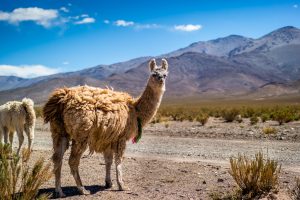5 Fun Facts About Llamas
Llamas are without doubt some of the fluffiest animals on earth – but there is so much more to these super smart fluff balls! Native to South America, these highly social mammals’ natural habitat is the Andes mountains, while they have adapted to a range of different environments. Trying to tell a llama apart from an alpaca? Llamas are roughly twice the size of alpacas and have much longer ears!
Keen to learn more about these unbelievably cute creatures? Let us introduce you to the camel’s “hippie cousin” with the following five fun facts!

1. Llamas tell their companions off by spitting at them
One of the best-known facts about llamas – if you irritate one, they will stick their tongue out at you! The good news is they won’t bite, but the usually very social llamas show their dislike by sticking their tongue out or even spitting partially digested food (mostly grass) as far as 4.5 meters (15 feet). Talk about good nonverbal communication skills!
2. They will tell you their boundaries
Llamas are not only sociable and soft but also extremely resilient! They have adapted to live in harsh environments and are commonly used as pack animals in South America. In fact, they can carry up to 90kg (200 pounds) around for the whole day. The cool thing here is that llamas do know their limits and they will refuse to move or just lie down when you overpack them!
3. Llama language is humming
Did you know that llamas communicate with each other by… humming? While they also use heaps of body language tools such as ear, tail, and body postures, humming is their primary way of communication. By generating a sort of wordless noise with their mouth shut, llamas can warn their herd in case of danger.
Never heard about this fun fact about llamas before? Give it a listen!

4. Plant-based superheroes
Considering that llamas are still primarily used as pack animals in South America, it is mind-blowing to know that these foregut fermenters only feed on grass and other plants. This is thanks to their super-efficient digestive system! On top of that, llamas don’t need a lot of water as they derive it from the plants they consume. That way, these tough animals can even thrive in less optimal conditions and challenging environments.
But the best is yet to come! Llama poop is known to be almost odor-free. It is a great eco-friendly fertilizer and the Inca even used to dry the ‘Llama beans’ in the sun, burn them and then use them as fuel.
5. Therapy dogs are old-school – therapy llamas are the new trend!
Besides providing humans with wool and meat, and helping out as pack animals, llamas nowadays got themselves the rather unusual job as therapists! Working as therapy animals, llamas are used as fluffy comforters in nursing homes, schools, and hospitals. These charismatic companions with their empathetic gaze seem to have a sixth sense about frail or needy people and are therefore used increasingly in therapeutic settings.
Now that you have learned a few fun facts about llamas, why don’t you go see these adorable fluffballs for yourself?
Join us on one of our tours to South America and contact us to plan your trip of a lifetime!
Maybe pay an unforgettable visit to Machu Picchu on our Signature Peru tour to see some llamas wandering free around the famous ruins?

Where Will You Go Next ?
- Popular Destinations
- Antarctica
- The Arctic
- South America
- Central America
- More to explore
- Amazon
- Antarctic Circle
- Antarctic Peninsula
- Argentina
- Bolivia
- Brazil
- Canadian Arctic
- Chile
- Colombia
- Costa Rica & Panama
- East Antarctica
- Ecuador
- Galapagos Islands
- Greenland
- Guatemala & Honduras
- Machu Picchu
- Mexico
- Patagonia
- Peru
- South Georgia and Falkland Islands
- Spitsbergen
- Sub Antarctic Islands

Talk to one of our experienced Destination Specialists to turn your Antarctic, Arctic and South American dream into a reality.
Contact us